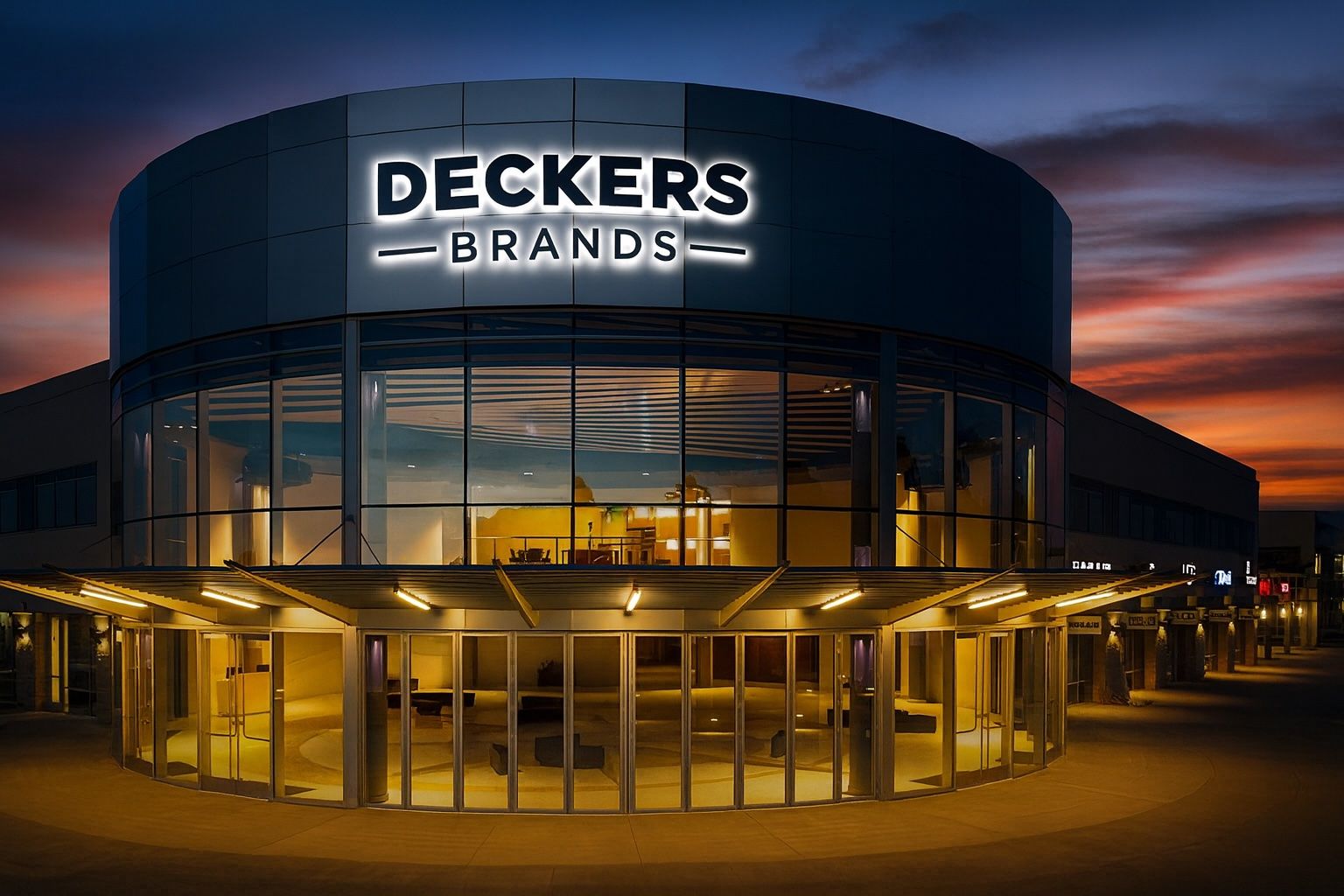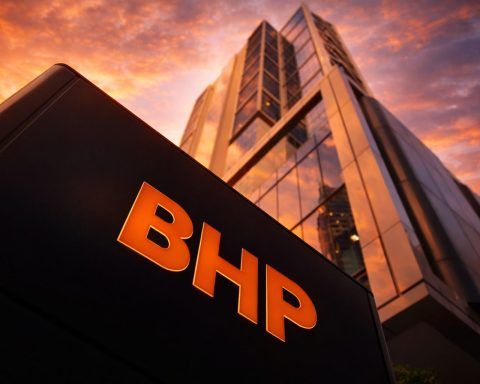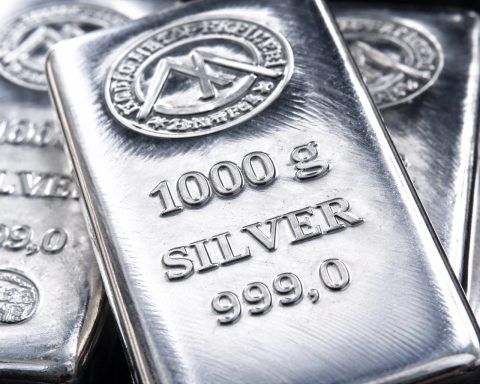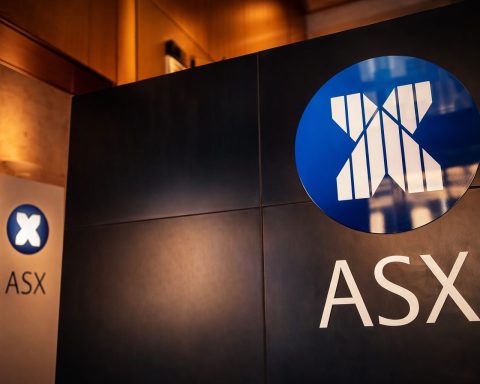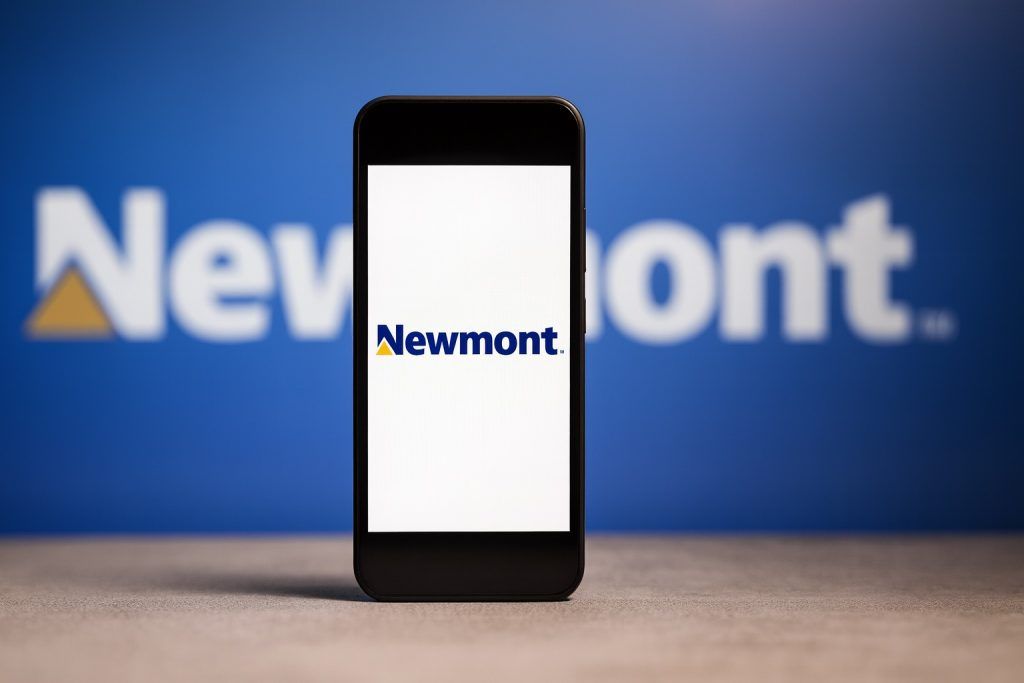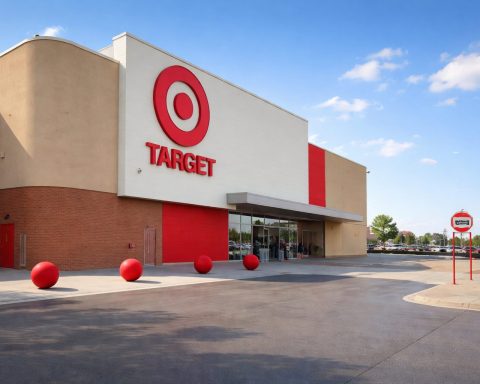- Recent Price Action: Deckers (NYSE: DECK) closed around $102.50 on Oct. 23, 2025 [1], roughly 33% below its level a year ago. Trading had been choppy (roughly $99–$103 in early Oct.), but the stock plummeted ~9–12% in after-hours trading following its Oct. 23 earnings release [2] [3]. (If prices hold, this would mark one of DECK’s largest drops in months.)
- Q2 Earnings Beat: In Q2 FY2026 (quarter ending Sept. 30), Deckers reported revenue of $1.431 billion (+9.1% year-over-year) and EPS $1.82 [4]. Both figures topped Wall Street’s roughly $1.42 billion and $1.58 estimates [5]. Growth was broad: HOKA brand sales jumped ~11.1% (to $634.1 M) and UGG sales +10.1% (to $759.6 M) [6], led by strong demand overseas. (U.S. sales dipped ~1.7% [7].)
- Mixed Guidance: Deckers raised its full-year forecast but missed analysts’ targets. The company now expects FY2026 sales of about $5.35 billion and EPS of $6.30–$6.39 [8] – below the roughly $5.45 B sales and $6.32 EPS Wall Street had anticipated [9]. Management cited “rising economic uncertainty” and tariff impacts (now estimated at ~$150 M) as headwinds [10] [11].
- Market Reaction: The weak outlook spooked investors. DECK shares fell sharply in after-hours trading (about 12% down, according to Reuters [12]) and ended Oct. 23 in the mid-$90s [13]. By contrast, many retail peers (like Nike and Adidas) recently beat forecasts and even raised guidance [14], highlighting the split in the industry. (U.S. holiday spending is expected to grow only modestly this year, as consumers stay cautious [15] [16].)
- Analyst Views: Wall Street took notice. Analysts have cut price targets and ratings: for example, Jefferies trimmed its 12-month target to $107 (Hold) [17], and Bernstein started coverage at Underperform ($100) in mid-Oct [18]. According to MarketBeat, price targets on Deckers now range roughly $100–$136, with a consensus “Moderate Buy” and average target around $136 [19] [20]. (Seaport research recently lowered Q3 EPS estimates to $2.75 [21].) Overall sentiment is cautious: many analysts have “Hold/Neutral” ratings, reflecting the near-term uncertainty [22].
- Balance Sheet & Brands: Deckers enters this period in strong financial shape. The company is debt-free with ~$1.4 B cash on hand, and it bought back ~$282 M of stock in Q2 [23] (over 2.6 M shares at ~$109 each). Its key brands – HOKA and UGG – continue to drive growth (each up double-digits internationally) [24] [25], which underpins long-term optimism. (For context, Deckers’ previous CEO noted in 2024 that “Hoka and Ugg are two of the healthiest brands in the industry” [26].)
Stock Performance & Recent Trend
Deckers’ share price had been trading around the low-$100s in mid-October 2025. On Oct. 23, 2025 it closed at about $102.54 [27]. Trading volumes spiked into the millions on that day (roughly 8.8M shares, well above normal), as investors braced for earnings. Early on Oct. 23, DECK was up slightly for the week, but the big move came after markets closed. In after-hours trading on Oct. 23, DECK plunged roughly 9–12% into the mid-$90s [28] [29]. This wiped out most of the day’s gains and reflected investor nervousness. (By contrast, over the past 12 months DECK is down about 32–33% [30].)
As of Oct. 24, 2025, Deckers stock remains well below its spring 2024 highs (~$220) and trades at a modest valuation (around 15–17× forward earnings [31] [32]). The sharp post-earnings drop pushed sentiment to be short-term negative, with many traders moving to the sidelines until signs of stabilization.
Q2 Earnings and Guidance
On Oct. 23, 2025 Deckers reported its second-quarter (fiscal Q2 FY2026) results. The company delivered strong top- and bottom-line growth, easily beating expectations [33] [34]. Net sales were $1.431 billion, up 9.1% year-over-year [35], above analysts’ $1.42 B forecast [36]. Earnings-per-share were $1.82, up 14% from a year ago [37] and topping the ~$1.58 consensus [38]. Growth came largely from Deckers’ flagship brands: HOKA sales jumped 11.1% to $634.1 M and UGG sales rose 10.1% to $759.6 M [39]. These gains were fueled by international demand and new products. (Other smaller brands like Teva/Sanuk accounted for most of the slight sales declines.) Notably, domestic U.S. sales slipped ~1.7% [40], highlighting that U.S. consumers are becoming more cautious.
After the beat, Deckers updated its outlook. The company now forecasts FY2026 net sales of roughly $5.35 billion and EPS in a $6.30–$6.39 range [41]. Although this is an increase over prior guidance, it fell short of Wall Street’s expectations (Street consensus was near $5.45 B and $6.32 EPS) [42]. Management explicitly warned that tariffs and inflation are pressuring consumer spending: CEO Stefano Caroti noted “a more cautious consumer” in the U.S. due to tariff- and price-related impacts [43]. The company now estimates an unmitigated tariff drag of about $150 million this year (down from $185M prior). In sum, Deckers beat the quarter but its full-year guidance was conservative, citing economic uncertainty [44] [45].
Analyst and Expert Commentary
Financial analysts reacted swiftly to the cautious guide. Immediately after the call, many price targets were cut. For example, Jefferies trimmed its 12-month Deckers target to $107 (maintaining a Hold rating) [46]. Sanford Bernstein, which began coverage mid-October, opened with an Underperform rating and a $100 target [47]. Other firms (TD Cowen, UBS, Evercore, etc.) have also lowered targets in recent weeks. According to a MarketBeat report, analyst price targets on DECK now span roughly $100 to $136, with a consensus “Moderate Buy” and average target about $136 [48] [49]. Zacks Investment Research has Deckers at a #3 (Hold) rating (reflecting lowered EPS estimates) and notes DECK’s forward P/E is about 15.7 [50] – slightly below the sector average, implying the stock isn’t overly expensive given its growth.
Expert voices highlighted the same themes. eMarketer analyst Rachel Wolff called the forecast “disappointing” but understood the caution going into a potentially tough holiday season [51]. On calls, management emphasized a conservative stance. Still, some longer-term bulls see opportunity: Deckers’ strong cash position ($1.4B cash, no debt) and core brand momentum may support a rebound if conditions improve. For example, an analyst noted that at ~15–17× expected 2026 EPS, Deckers’ valuation already “prices in significant uncertainty” [52]. In other words, the risk may be largely reflected in the current price.
Broader Market and Retail Context
Deckers’ results and outlook came amid a mixed retail environment. Broadly, U.S. consumer sentiment has remained cautious. Recent data show middle- and lower-income shoppers are pinching pennies under high prices [53], while higher-income consumers continue spending (especially on premium products). The November–December holiday season is expected to see only modest sales growth – forecasts hover around ~2–2.5% gains [54], down from ~4% last year – as trade tensions and inflation dampen exuberant spending [55] [56]. Several large retailers have given mixed signals: Walmart and Macy’s raised outlooks, but others like Mattel cut guidance [57]. This cautious backdrop helps explain Deckers’ conservative guidance.
Meanwhile, some of Deckers’ peers have had brighter reports. For example, Nike recently beat revenue targets and said it’s clearing excess inventory (its stock jumped ~4.5% in early October) [58]. Adidas also raised its profit outlook on Oct. 23, noting it largely absorbed U.S. tariff costs through price hikes [59]. In this setting, Deckers’ weaker consumer tone stands out. Interest rates may play a role: futures markets see a Fed rate cut as likely by late Oct. 2025 [60]. If borrowing costs ease, consumer spending could slowly revive in 2026. That potential recovery (and Deckers’ cost of capital) is something investors will watch closely.
Sector-wise, Deckers sits in the Consumer Discretionary – Apparel & Footwear group. As an “affordable luxury” footwear maker, it straddles performance and lifestyle. High-end footwear has still shown resilience (as wealthier buyers remain strong) [61]. Deckers’ stock has suffered more than the average retailer this year – partly because it was a high-flyer in 2021–22 (with a peak above $223) and now the pullback looks bigger. For context, the stock’s 12-month low is around $93.7 [62] (hit during the recent drop) and high was $223.98 (in mid-2023) [63].
Company & Brands Overview
Deckers Outdoor is best known for its global footwear brands. Its biggest contributors are HOKA (running shoes) and UGG (shearling-lined boots). Both saw double-digit growth in the recent quarter [64]. UGG, originally famous for sheepskin boots, has broadened into fashion and outdoors; HOKA has become a leader in high-performance running shoes. Deckers also owns smaller labels (Teva, Sanuk, Koolaburra), but those have much lower sales (Koolaburra is being phased out, for example [65]). Management has repeatedly said that HOKA and UGG are key growth drivers going forward. In fact, in prior earnings the CEO has called them “incredible – and still increasing – brand heat” [66]. For FY2026, Deckers expects HOKA sales to grow in the low-teens and UGG in the low- to mid-single digits [67], reflecting slower U.S. demand but strong international momentum.
The company’s strategy is to capitalize on these brands with new product lines, global expansion, and by managing inventory tightly. Deckers also points to its strong balance sheet as a competitive advantage – it reported zero debt and is aggressively buying back shares (with $2.2B still authorized [68]). These factors give it flexibility in tough times.
Outlook and Takeaways
In summary, Deckers’ stock is under pressure after the latest results. The disappointing full-year guidance (despite a solid quarter) triggered a sharp sell-off [69] [70]. Analysts and investors are now watching several things for signs of recovery: Will U.S. consumer demand stabilize? Can tariffs and costs be absorbed? How will holiday sales (Nov–Dec) shape up? If Deckers can restart growth or if consumer confidence improves, the stock could rebound. As one expert noted, the current valuation already “prices in” much of the near-term risk [71]. On the flip side, if macro pressures persist, DECK may stay volatile.
For now, analysts broadly view Deckers with guarded optimism. Ratings skew toward Hold/Buy (none extreme), and the brand story (Hoka and UGG) remains compelling. But short-term sentiment is wary: Deckers’ beaten-down share price reflects the uncertainty in retail right now. Over the coming months, the market will see whether the company’s premium brands can defy the weak backdrop or if cost headwinds continue to bite.
Sources: Cited company filings and press releases [72] [73]; financial news reports and analyses [74] [75] [76] [77]; market commentary [78] [79] [80]; sector and economic data [81] [82] [83]. These sources provide the latest stock data, earnings figures and expert insights as of Oct. 24, 2025.
References
1. ts2.tech, 2. ts2.tech, 3. www.reuters.com, 4. ir.deckers.com, 5. www.reuters.com, 6. ir.deckers.com, 7. ir.deckers.com, 8. ir.deckers.com, 9. www.reuters.com, 10. www.reuters.com, 11. www.reuters.com, 12. www.reuters.com, 13. ts2.tech, 14. ts2.tech, 15. www.reuters.com, 16. www.reuters.com, 17. ts2.tech, 18. ts2.tech, 19. www.marketbeat.com, 20. www.marketbeat.com, 21. www.marketbeat.com, 22. ts2.tech, 23. ir.deckers.com, 24. ir.deckers.com, 25. ts2.tech, 26. www.retaildive.com, 27. ts2.tech, 28. ts2.tech, 29. www.reuters.com, 30. ts2.tech, 31. ts2.tech, 32. www.nasdaq.com, 33. ir.deckers.com, 34. www.reuters.com, 35. ir.deckers.com, 36. www.reuters.com, 37. ir.deckers.com, 38. www.reuters.com, 39. ir.deckers.com, 40. ir.deckers.com, 41. ir.deckers.com, 42. www.reuters.com, 43. www.reuters.com, 44. www.reuters.com, 45. www.reuters.com, 46. ts2.tech, 47. ts2.tech, 48. www.marketbeat.com, 49. www.marketbeat.com, 50. www.nasdaq.com, 51. www.reuters.com, 52. ts2.tech, 53. www.reuters.com, 54. www.reuters.com, 55. www.reuters.com, 56. www.reuters.com, 57. www.reuters.com, 58. ts2.tech, 59. ts2.tech, 60. ts2.tech, 61. www.reuters.com, 62. www.marketbeat.com, 63. www.marketbeat.com, 64. ir.deckers.com, 65. ir.deckers.com, 66. www.retaildive.com, 67. ir.deckers.com, 68. ir.deckers.com, 69. ts2.tech, 70. www.reuters.com, 71. ts2.tech, 72. ir.deckers.com, 73. ir.deckers.com, 74. ts2.tech, 75. ts2.tech, 76. www.reuters.com, 77. www.reuters.com, 78. ts2.tech, 79. ts2.tech, 80. www.marketbeat.com, 81. www.reuters.com, 82. www.reuters.com, 83. www.reuters.com
